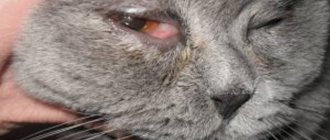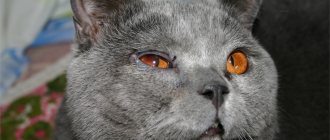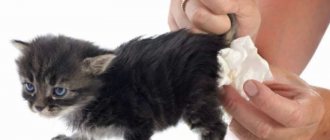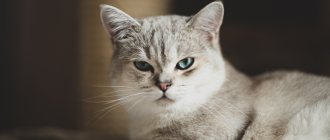Character and disposition
The peculiarity of the formation of the character of furry aristocrats is that they can be educated up to 1 year, maximum up to 1.5 years. Before this age, you need to inculcate the right skills.
Otherwise, you will have to put up with established habits or engage in re-education throughout your life. Here are the main pros and cons of the complex nature of these cats. Advantages:
- only go to the litter box;
- do not spoil things in the house;
- loyal to the owner;
- lenient towards children;
- calm and independent;
- moderately active
- make contact.
Flaws:
- waywardness;
- love themselves;
- stubbornness;
- touchiness;
- rancor.
The character of the British has many more advantages.
Aggressive cat: what to do and where to run
Cats are very sensitive creatures with a subtle psychology, so their behavior is significantly influenced by external factors, especially strong emotions such as fear.
A cat that is afraid of something takes a characteristic pose - it presses its ears tightly to its head and moves them back, presses its head and body to the ground, tries to become more invisible, in many cases the animal simply tries to run away.
If it doesn’t run away, it tries to defend itself. A cat that is ready to defend itself looks like this - it raises its paws and swings them, makes sounds similar to spitting, hisses, its fur stands on end (especially on the tail, head and back), its back arches and the animal moves sideways forward, so a cat tries to show its superiority (including in size) and intimidate the enemy.
In most cases, fear is the main cause of aggression in cats. If your pet is timid, you should never deliberately provoke fear; you should also ask your friends and acquaintances to approach the animal slowly, not abruptly, and say kind words as they do so. Only in this way can possible aggression on his part be neutralized.
If the cat is ready to attack, is aggressive, you can spray water on it from a spray bottle, this will cool its ardor. If an animal scratches a smooth surface out of despair, it means that it has lost control of the situation. In this case, you need to put some kind of rug on the cat so that she can sharpen her claws on it, or wrap her in a warm cloth - this way the cat will calm down faster.
Another reason for cat aggression is defense of territory. If there are several animals living in your home, especially if you are the owner of several cats that have reached sexual maturity, they may begin to fight for leadership. To prevent this from happening, introduce the cats correctly in the first days.
The animal that lived with you before should definitely receive more attention - this way it will not feel threatened and will not become jealous. As a rule, cats that live together eat from the same bowls and use the same litter box, but this can cause aggression. Cat utensils should be separated as soon as you notice that the animals are demonstratively avoiding the litter box or fighting around the bowls.
Different smells of animals can cause them to fight, so the manifestation of aggression of one pet towards another can be reduced by bathing them with the same shampoo or spraying them with the same cologne.
Neutered cats, as a rule, are less aggressive, and even sworn enemies can be reconciled. But it is better to castrate animals between the ages of seven months and 1 year, until they acquire the habit of showing aggression and marking territory.
Often those who keep cats confuse their bites with aggression. Small kittens may bite you because their jaws itch (due to teething). Invite them to chew bones, but only those that they cannot chew, or large pieces of meat. Never feed bones from small animals and birds, or chicken bones, as kittens can chew them, causing damage to the gastrointestinal tract.
Often, when the owner tries to pet his pet, he may begin to bite, especially if you want to scratch the cat’s tummy (the stomach for cats is the most vulnerable place, if the animal allows you to scratch its tummy, it means it is subordinate to you and completely trusts you). However, this does not always mean that the cat is aggressive; most likely, your pet is simply not in the mood for communication at the moment or she does not like your affection.
Under no circumstances should you hit cats that show aggression - this will only make the situation worse. If possible, you need to eliminate the cause of the aggression and cool the animal’s ardor with a stream of water.
The following method may also help. You've probably seen how cats behave during fights (swinging their paws at each other, hissing) or mother cats with their children (ruffling them and holding them by the withers). You must do the same - lightly shake the animal by the scruff of the neck, lightly tap it on the nose with your finger, imitate the waving of cats' paws during a fight, hiss at it menacingly and be sure to look the cat in the eyes, since the one who looks away first will “lose” - These are the cat “rules”. You must ensure that your pet looks away, he will become somewhat confused, begin to hesitate, may begin to leave or lick himself - this all means that the animal has recognized you as the leader.
Did you like the article? Click the button and share with your friends! Let there be more happy people and cats!
brit-cats.ru
Relationship with the owner
A true Briton is smug and self-sufficient, and views his owners as breadwinners. It is not without reason that this breed is considered suitable for business people. They don't like to sit on their hands and can't stand noisy companies at all.
After a long day of work, the pet will greet the person reverently and tenderly, and will rub against the legs. They don’t like it when the owner stays late somewhere and doesn’t come home from work on time.
The short-haired British aristocrat purrs and purrs only to selected people. Plush pets guard their boundaries and get used only to those who feed and care for them. Only this person will have them sit on his lap.
If there is a child in the family, you should not have a Briton for his entertainment. Representatives of this breed are very patient with children, but they will not allow themselves to be made into toys. They will hide and run away.
It is very rare for a straight-eared Briton to be “tame.” He doesn't often ask to be held and petted. However, when he needs to climb onto his owner’s lap, he will follow along until he achieves his goal.
About activity
The character of British kittens, like cats, can actually be reserved and sometimes even cold, but this does not in any way affect their activity. The British sleep a lot, but in their free time they will do what they want: run, jump, play. The exception in this case is only older representatives of the breed. Pets that have access to the street are more active. They are interested in everything around them: leaves, butterflies, flowers, so cats can spend hours on end outside. If there are several cats in the family, then additional activity will be provided. This is very good, since active animals have much fewer health problems.
Important! To prevent your cat from lying around in the apartment, you should play with him from time to time and offer him some options for useful ways to spend his waking hours.
Attitude towards other animals
If you already have an animal in the house and you decide to get a British one, then it is very difficult to guess how the relationship will develop. Representatives of this breed have a rather capricious character, everything is very individual.
There are no particular problems with other pets. Relationships can be very good if a British kitten and another cat or dog are taken into the house at the same time. They are still getting used to each other as babies.
Material on the topic: what is the British cat breed.
In the case when an adult is taken into the house, everything depends on how the other animal will treat the representative of the British breed. They really don't like being bothered. It doesn’t matter what kind of pet is next to them in the same apartment. The main thing to maintain calm is to simply not bully or touch them.
Britons usually get along easily with other animals.
Care and maintenance
British cats, although unpretentious, still need hygienic and medical procedures.
Moving into a new home
A new home needs a basic set of items:
- The first thing you need to arrange is a sleeping place. It should be warm, cozy and dry. A store-bought bed or a regular warm blanket that can be spread on the sofa will do.
- The tray is installed in a quiet but accessible place. It is better to use wood filler. It absorbs odors well, has a low price, and can be changed every 1-2 days. British aristocrats cannot relieve themselves in a dirty pan.
- Carrying required. It is used for travel and trips to the veterinarian.
- Food area. A bowl for water, a bowl for dry food, and a bowl for wet food or treats are a must. The water is changed daily.
- A scratching post is a necessary attribute of any predator. Without it, the pet will still sharpen its claws, only on furniture.
- Claw cutter. Needed for trimming claws.
- You will need a number of toys. Information from the breeder will help you choose toys in accordance with the kitten’s character.
Important!
The environment surrounding cats should be safe, clean and comfortable.
Hygiene and medical procedures
There are several rules of care:
- British breeds require weekly brushing. They shed regularly (usually in spring and autumn), but even without shedding they lose a lot of hair, which does not make their owners happy. The procedure helps maintain a well-groomed appearance and protects pets from swallowing fur.
- Bathing is carried out once every 3 months, or better yet, 1-2 times a year. The British are very clean, so they can easily do without water procedures. When washing, use a special cat shampoo.
- Nails are trimmed every 15-20 days. This relieves the animal from discomfort and protects the furniture from scratches. Use a special nail clipper. Conventional scissors delaminate the plate and cause injuries.
- It is recommended to regularly examine your pet's oral cavity. Teeth brushing is carried out at least once a week. This will protect cats from tartar.
Important!
Owners will need to get sticky rollers and a good vacuum cleaner to get rid of cat hair more thoroughly. Even combing does not protect the house from fur.
Basic medical procedures:
- From the age of 3 months, British kittens begin to be vaccinated. Vaccinations protect against infectious diseases. Revaccination is carried out once a year.
- From 7-10 months it is recommended to carry out sterilization and castration. The operation is painless. It prolongs the life of the animal and protects it from stress.
- Every season a preventative treatment for worms and fleas is carried out.
Information about other procedures is provided by your personal veterinarian.
Diet
British people have a good appetite, so they have a tendency to gain excess weight.
Important!
The British are very picky eaters, it is important to take into account their tastes. Some people won't eat dry food even if you starve them.
British cats should not be fed cheap dry food such as Kitekat and Whiskas. From such food they will develop problems with digestion, the genitourinary system, and hair will come out. It is safer to use premium brands or holistic food.
List of popular brands of dry food:
- Royal Canin;
- AATU;
- Acana;
- Bozita;
- Savarra, etc.
They have a rich composition and a good vitamin and mineral complex.
Some owners take full responsibility for the animal’s diet and switch them to natural food.
Natural menu:
- The main diet is meat, at least 80%. This can be turkey, chicken, rabbit, beef, veal and fish. Avoid pork completely; it has a negative impact on health.
- The remaining 20% comes from boiled vegetables, herbs and cereals.
- It is acceptable to occasionally treat your cat with fermented milk products. Low-fat kefir and low-fat cottage cheese are suitable.
- You can give cats boiled eggs.
- It is acceptable to treat your pet with interesting treats, but only those intended for cats.
- Vitamin and mineral supplements are recommended to maintain health. They are selected individually for each pet.
Adults are fed 2-3 times a day. Kittens can eat more often - up to 5 times a day. The environment in the food area must be clean.
Attitude towards children
The presence of cats in the house has a very beneficial effect on the development of children. They create a favorable environment and promote the production of “happiness hormones.” Quite often in families with one child, you can hear complaints from parents that the baby is growing up capricious, spoiled, and misbehaving. A furry pet in the house changes the psyche of children for the better.
The animal partially switches the parents' attention from the child to themselves, reducing the intensity of excessive care. The child may begin to talk to the cat, which will help with speech development. By playing with a pet, children develop fine and gross motor skills.
Some psychologists even argue that having an animal in childhood helps you cope more easily with adolescence, and then in family life. Such children, and subsequently adults, are kind, sociable, and treat others with understanding.
It is believed that cats strengthen the baby's immunity. They bring their own microflora, which the baby will encounter outside the home, and make it possible to resist various diseases.
Parents often worry about their child's allergies. Before adopting a pet, consult your doctor. It is believed that children who grew up with animals are less susceptible to allergies.
Origin of the shorthaired breed
As you might guess, the British straight-eared cat first became known on British territory. Those interested in it often have questions about the age of the breed. The fact is that no one had previously been particularly involved in describing the origin of breeds. Stud book records arose much later. To illustrate this statement, it is enough to say that the breed received a standard and pedigree only at the very end of the century before last, namely in 1898.
However, there is some information about when to start counting the breed. Researchers suggest, and not without reason, that the age of this wonderful breed is similar to the age of the Roman Empire! Where did such information about the origin come from if there were no stud books? It's time to turn to ancient images of that period. On them you can see cats that are strikingly similar to modern representatives of the British breed.
IMPORTANT: By the way, initially this cat was short-haired.
It is possible that it was precisely this short, tightly knit coat that the breed reached such an impressive age. The cat was given the opportunity to survive in any conditions. In addition, the cover helped the ancient representatives of the breed to always look quite representative. The gray color of the plush fur is exactly the universal color that most owners like.
In addition to the color and texture of the coat, the breed attracted such characteristics as endurance and enviable physical strength. The British cat is developed, has a massive back and shoulders. Quite muscular legs can also be considered a feature. As a result, the weight of representatives of the breed is rather large - from 5 to 8 kg with a height of 9-14 cm. What is unique is that with such height and weight, the breed managed to look quite harmonious and move gracefully.
It is quite natural that such a hardy, physically developed cat found a place among Roman sailors. They gladly took animals with them - this is how it was around the 2nd century BC. The breed appeared on British lands. Graceful animals with a mysterious gray color immediately fell in love with local residents. This color is also called blue. Even today it is very popular, and many centuries ago, according to surviving information, it was the only option.
In many ways, the age of the short-haired breed is so impressive because its representatives brought by the Romans crossed not only with each other, but also with wild cats. Given the isolation of the area, the breed concentrated on the islands, acquiring resistance to the legendary British rainy and windy climate. Which, of course, is a huge advantage when kept in our latitudes.
Bad habits
Just like people, cats have bad habits. No, they don't smoke or drink alcohol, or even use drugs. They have a different world and other bad habits. As a rule, they take up to a year to form.
British cats can take offense at their owners.
British babies can start biting their hands as early as 4 months. They, like small children at this age, are teething. This problem can be easily solved with special teethers.
The owner's hands will be the favorite teething tool if you don't wean him off this habit in time. Having matured, a British cat can bite constantly.
A Briton can push his owner out of bed.
When a little kitten sleeps in the same bed as its owner, it looks quite cute. The fluffy little ball is snoring peacefully nearby.
But when he grows up, he begins to consider the bed his territory, and sometimes the owner will survive from his own bed. Therefore, while the kitten is small, designate the territory where he is not allowed to go, show acceptable boundaries.
Kittens love to watch things fall from the table, from the bedside table, they will throw away everything that is “badly worth it.” It is necessary to wean the animal from this habit in early childhood. Otherwise, on the floor there will be not only a pencil, but also an expensive telephone, a vase of flowers, dishes and everything that falls cheerfully and loudly.
They treat toys the same way as small children - their interest in them is very short-lived. For a maximum of one day, the fluffy will play with a new entertainment, and then interest disappears, the toy will gather dust in the corner.
To give your kitten toys that don't put a strain on your budget, make them yourself. Pencils, tennis balls, and ping pong balls are suitable for active games.
Nothing can replace personal attention to your pet. Nowadays, we spend a lot of time at the computer. As a break, play with your fluffy fidget, then he will learn to occupy himself independently when his owners are not around.
It is worth getting personal toys for your British cat.
Do the British have bad habits?
It is believed that aristocrats do not and cannot have bad habits. Of course, the behavior of British cats may sometimes not fit into the generally accepted framework of these peculiar animals, but in any case, representatives of other breeds should be compared to them. This is not entirely true.
There are several bad habits of British cats that you should be aware of:
- Using the owner's personal belongings as toys, as well as items that cannot be used for these purposes. We can talk about jewelry, tubes of creams, sweets. If there is no fear that the animal will take these items somewhere, then you should not take them from him. The kitten will frolic a little and will lose all interest in what was just found. Otherwise, it is better to pick up the item, but be sure to exchange it for any other one.
- Some animals love to climb inside bags, boxes, packages and cabinets. It is difficult to find an explanation for this, but this does not mean that the pet will immediately stop doing this. In this case, you can also do it in two ways - allow it to be done or try to wean it off by replacing one activity with another.
Britons may actually be skittish animals, but they are also very intelligent, playful and active pets.
Did you like the article?
Will it catch mice?
Following from history, British cats were specially bred to catch rats and mice. For successful hunting, breeders wanted to achieve a thick and short coat, so that it would be difficult for rodents to bite and injure the little catcher.
All representatives of this breed catch mice. This is genetically embedded in them. But in city apartments, as a rule, there is no opportunity to hunt at all.
Some owners take their British Shorthair cat with them to the countryside. There they catch all the mice in the area within a week. They most often bring their prey to the owner. When the rodents run out, the hunt begins for frogs, large insects, and birds. Cats are more graceful and passionate in hunting than cats.
The British are born mousecatchers.
Owners' opinion
Domestic British cats. Character, reviews:
- For many people, the waywardness of the British does not seem to be a problem. You can get used to it. If you are patient, show love and care, the cat will reciprocate;
- Many people like the ease of care associated with natural cleanliness. Still, when your corners, sofas and slippers remain intact, it’s nice.
So, according to most owners, this cat is a gift from fate. She is kind, calm, and adequate from a very early age. Fortunately, the character of any purebred British cat is quite acceptable even for a family with a small child.
4.4 / 5 ( 308 votes)
Features of behavior
The characteristics of the British determine their habits and habits. Let's look at the behavior in basic terms.
Devotion
We are accustomed to the fact that the palm in loyalty belongs to dogs. According to prevailing stereotypes, it is difficult to imagine such a quality in a cat. Cats are self-sufficient, they are born with this feeling. Since the times of Ancient Egypt, it has been known that cats are connected with the afterlife and bring their special energy into the house. Watch the video, it presents some of the character traits of the British cat breed.
They love to clean the energy field, align it with their owner, and protect the territory from negative energy influences. The British will only be faithful to someone who gives her a lot of positive emotions, plays with them and expresses his love for them.
Patience
This is one of the defining character traits of British cats. They tolerate everything from small children. Little children love to explore the world, touch, stroke, pull the tail and whiskers, and do a lot of unpleasant things to the poor cat. But they steadfastly endure all these medieval tortures, realizing that the child is too small and simply does not understand that an animal can be in pain.
Friendliness
Friendliness is one of the main traits of this breed. They can be friends with everyone. At an early age, they love to play a lot and are active; they can hit someone with their paw while playing. Growing up, they are friends with cats and dogs in equal measure.
Cleanliness
A high degree of cleanliness sets the British apart from the entire cat family. They quickly become accustomed to the litter tray, adopt good manners and lick themselves very thoroughly. Their coat is always clean and tidy, as if they take care of their appearance. By licking themselves, they relieve stress.
Stubbornness
The British will not follow your orders unquestioningly. If they are busy with something, they will not tear themselves away from what they are doing for nothing. They do not tolerate orders, no matter what you say and in what tone.
Psychology of British cats
The character of British cats is very multifaceted and depends on certain factors, but their psychology is simple. Mood greatly influences your pet's behavior. The owner's attitude can change the animal's mood, so it is important that the pet never feels lonely and abandoned.
If a Briton is sad, it is simply necessary to devote more time to the animal, for example, with games. Never get angry with your pet. British cats hold grudges for a long time. Oddly enough, the characteristics of the breed influence the nature. Thus, long-haired representatives are more friendly and never hide their love.
How to choose a British kitten and how much it costs
It is best to purchase a British kitten from a well-established cattery. A responsible breeder takes care of the health of breeding animals and babies and gives comprehensive recommendations on care and maintenance. In a good nursery, a kitten can be purchased no earlier than three months of age, when it is completely ready to be transferred to a new home - twice vaccinated, socialized, well raised (at least accustomed to a tray and a scratching post). The average cost of such kittens is 10,000 rubles.
If the animal is planned for breeding, it is better to choose a grown-up female cat, about a year old, when all the breed's advantages and disadvantages are clearly visible. The cost of such an animal suitable for breeding starts from 20,0000 – 30,000 rubles.










